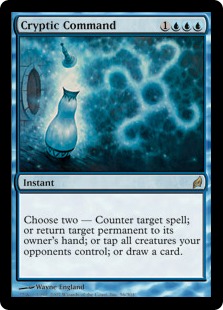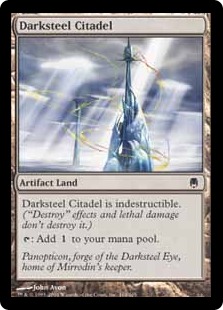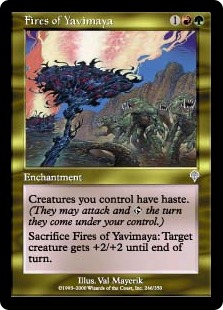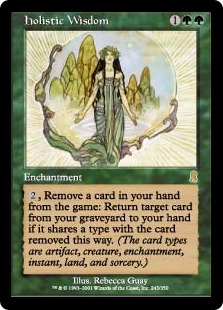
Oh, the time is soon approaching when our high dollar cards from the Lowryn set will fall in value with the release of Zendikar. Maybe a few of the exceptional rares as Mutavault and Thoughtseize will retain some of their value. More than likely, the majority will drop from five dollar expenditure to one dollar thrifty must have. Besides the fact Zendikar will decrease the prices of my decks, my thoughts turn to how the release of it will change the metagame. The loss of Lowryn will be dramatic in that we will no longer have those adorable Kithkin threatening to gang up on us by turn five or the Fairie menace will finally be dead. In my personal opinion, the format will be slower and netdecks will revolve on power level instead of synergy. Naya will rule the day! I may be a little presumptuous in such a statement. Sure as heck, when the full spoiler for Zendikar set is released, authors will clamor on how the cards will impact the meta. I don’t care for many of these articles.
Here is an excerpt:
This card is awesome and will go in any deck to beat this card. However, the power level of cards in white will be skyrocketing with this card with another card in green will become dominate. Did I mention card is awesome? Everyone will rush to get card, but the card is tier two at best. In my prediction, card will define the metagame. I have over the years heard a lot about card, card, card, card and card. In case I forgot, card, card, card, and card. Zzzz...
Picking your Poison
During the rare occasion I get out for an FNM, my deck choice is based upon the cards I can afford. Hence, I don’t play Vintage. In the rare instance money is no option, I decide upon my deck on more than just card or cards. I take great care in my decision because my pocket book is not limitless. This facet is probably true for many. To help facilitate the process, I developed a few terms, categories, and important stuff.
Flexibility
I like to pick a deck capable of innovation. Elves are great tribe to illustrate this facet. If you want, an elf deck can go aggro with Wren's Run Vanquishers and their Lords. Black-Green Elf decks have been taking a few Blue envelopes the last two years thanks to Tarmogoyfs and Putrid Leeches. The cool thing about elves, they can go combo if the metagame favors it. Extended has combo elves powered by Mirror Entity and Legacy with Survival of the Fittest. Standard has seen brief combo decks with Guilt-Leaf Archdruid taking all your lands or Regal Force drawing a few cards.

The other complication of a deck being inflexible results in a restricted sideboard. Going back to the Vial Affinity deck, the sideboard is restricted because of the deck. A person can’t dedicate 8 slots to graveyard hate in the sideboard to help Vial Affinity beat Dredge. A person can’t remove more than 8 cards out of the deck without destroying the functionality of it. The maximum amount of slots for graveyard hate can only be about 4 cards. I remember a large amount of people had problems with Gabriel Nassif’s sideboard with all of the singletons. Why would he want four of anything when he would only take out, at the most, 4 cards? The majority of the time a person piloting the deck would make only one or two changes between games. I thought at the time at the cleverness of the sideboard. Plus, the singletons gave a wider range of cards to choose from during various matches.
In my humble opinion, it is an unwise investment to purchase cards for a deck incapable of flexibility. Each new expansion will change the metagame. It is a given. Will your deck be able to adapt? The more important question, can your deck adapt? Besides the investment, do you really want to play a one trick pony only good for one PTQ?
Durability

This is not to say I am knocking aggro or combo. All I am trying to get across is a deck should be capable of beating all three. Vial Goblins emulates a surprising sturdy deck for all its dorks. Goblin Ringleader and Goblin Matron provide the durability the deck needs against all these facets. Even if the board is wiped clean, Goblin Ringleader can quickly remedy the downfall. It isn’t necessarily just about card advantage. Going back to my elf fetish, Wren's Run Vanquisher, Imperious Perfect, Chameleon Colossus, and Putrid Leech are each a formidable threat. What do you make an opponent discard, counter, or when do you play Wrath of God? Each card represents a must counter. Nothing is better to me than being able to play a card each turn and asking the opponent if they are going to counter it. Are you going to let it resolve? Are you going to let it resolve? Are you going to let it resolve?
Combo decks can be fragile little creations. In the right setting, they are a force to be, well, you know. Dragonstorm showcases my point. Discard only put a small dent in the deck’s plans. Counterspells were thwarted with Gigadrowse. Wrath of God was irrelevant. The combo was annoyingly durable. Even the most aggro of decks couldn’t outpace the onslaught. As much as I respected the Dragonstorm decks of the day, they were really annoying for how quick, powerful and resilient the deck could be.
Speed

Standard commonly sets the level by the aggro decks in the meta. Kithkin, Black-Green Elves and more recently, tokens have defined the format. I am not trying to say control decks fail to influence the metagame. What I am getting at is that control decks must be capable of beating the fastest aggro decks. If they can’t, control is not an option. Goblins and Vial Affinity in the past raised the bar for Legacy. A deck incapable of keeping up with these Juggernauts had no business being piloted. Strangely, the aggro/combo Dredge decks define much of the eternal formats of today.
Hate

Flow

Fairies, Elves and Kithkin are examples of decks with some phenomenal flow. The majority of starting hands can be kept for there is just about always a first turn play followed by many others. As the decks hit on all cylinders, they can be very unforgiving to an opponent who kept a clunky hand. On the same thought, the decks depend on the tempo they need in order to win. A starting hand with bad flow should be pitched. Therefore, when choosing a deck, I like to pick a deck with good flow or try to improve the flow rate. A deck with good flow will reduce the amount of mulligans I will need in a given tournament. A few mulligans here and there can put me at a great disadvantage in a competitive scene when every card counts.
Instead of flow, I could have used consistency. The word could be synonymous, but I like flow for the visual aspects it brings and the word isn’t very concisely defined. Flow at least has some room for interpretation. Some may point out this is merely tempo. Well, they can go hand in hand in some cases. Tempo doesn’t hold true for what I am trying to do or the thought process I want to utilize to improve my deck. Take my reanimator deck. It is a typical blue/black reanimator utilizing looter spells to dump big creatures in the graveyard such as Bogardan Hellkite, Angel of Despair, and Phantom Nishoba. Instead of playing mountains for Anger, I decided to opt for Dragon Breath instead. When I first constructed the deck, I had difficulty trying to find my reanimation spells at times. I found it inconsistent in a flame on flame off sort of way. To help the deck flow better, I pulled in Peer Through Depths to help the deck be more consistent by either finding my looting spells to dump creatures in hand or my reanimation spells. Saying Peer Through Depths helped improve the tempo of my deck is silly. It didn’t do anything. The spell simply helped me find the cards I needed. Adding Peer Through Depths helped the flow of my reanimator deck.
Power Level and Tempo
Just to ensure nobody points out I am missing these aspects. They are extremely important, but I won’t cover them since they have been done to death.
Holistic Magic

Rest assured, 50,000 other Magic players came to similar conclusions. The important part I am trying to get across in the article is sometimes we become too focused or obsessed on beating Bitterblossom or Cruel Ultimatum when we should be looking at the bigger picture. With this, we can tune our decks by making them either more durable, flexible, consistent, powerful or faster.
Comments